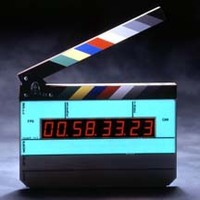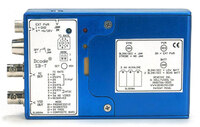Timecode Slating
There's not much point in recording timecode onto the audio if there is no timecode reference on the picture.
In the case of video, timecode is normally recorded onto the video signal even if audio is recorded double-system (i.e. onto a separate audio recorder). Jam-sync all of the timecodes, and that will take care of basic sync (video word sync is another matter, but engineers take care of that on the big shoots). In addition to jam-sync, use either a traditional or timecode clapstick just for protection.
If there is no timecode being recorded onto the video (i.e. prosumer camcorders), or the timecode in the camera cannot be accessed -- then you should use a timecode slate so that the editor can line up the picture with the audio.
When shooting in film, a timecode slate should be used for matching up picture with audio.
 The standard of the industry is the timecode slate manufactured by Denecke, Inc. Older versions of these slates were "dumb" slates and could only display the timecode being fed into them via a cable. Early on, mixers began using Comtek transmitters and receivers (similar to a radio mic) to send the timecode from the recorder to the slate, thus eliminating the awkward cable.
The standard of the industry is the timecode slate manufactured by Denecke, Inc. Older versions of these slates were "dumb" slates and could only display the timecode being fed into them via a cable. Early on, mixers began using Comtek transmitters and receivers (similar to a radio mic) to send the timecode from the recorder to the slate, thus eliminating the awkward cable.
Soon after, Mike Denecke came out with his portable sync box, which was a timecode generator that could be attached to the back of the slate. The addition of a self-contained timecode generator makes a slate into a "smart slate."
The sync box could be easily jam-sync'd to the recorder, and could hold sync for half a day. Of course, since re-jamming the timecode is so simple, mixers seldom wait that long.
The latest version of the Denecke slate, the TS-3, has a sync box built-in.
Obviously, when you are jam-syncing a smart slate to the recorder, you must use a form of Free-Run timecode, since the slate would have no way of knowing when you are in Record or Pause.
When doing sync playback, as in a music video, the timecode slate needs to display the code of the soundtrack being played back. Therefore, the slate must function as a dumb slate and receive a timecode feed from the recorder (playback source). This feed could come via a connecting cable (awkward!) or from a Comtek transmitter system (which is how it is normally done).
Make sure that you are familiar with how to use and set-up your timecode slate. Make sure that the internal settings for the slate’s timecode generator are set to match your audio settings in terms of frame rate and drop/non-drop.
If your camera will be using 24 fps (video rate), make sure you find out if it is actually just 23.976 or a true 24. Most of the time, it will be just 23.976.
In rare instances, you might need to cross sync 23.97 video with 29.97 audio (but that practice is no longer common). Some cameras, such as the RED, can cross-generate a 29.97 timecode for output to the slate and/or audio recorder. (It is possible, but can be tricky to the untrained.)
 Otherwise, you would need what is known as a tri-level sync box, such as the Denecke SB-T (seen right), to convert the 23.976 code into 29.97. Usually, tri-level sync is only an issue of really big, multi-camera shoots. In those instances, a video engineer in a white labcoat will make sure that everything is set up correctly.
Otherwise, you would need what is known as a tri-level sync box, such as the Denecke SB-T (seen right), to convert the 23.976 code into 29.97. Usually, tri-level sync is only an issue of really big, multi-camera shoots. In those instances, a video engineer in a white labcoat will make sure that everything is set up correctly.
However, most production houses are not that exacting. Set your slate and audio recorder for 23.976 if an option, or 29.97 otherwise, and just make sure that the camera sees a few frames of the slate. Back in post, the editor can match the start of the audio to the timecode slate numbers, and let the editing computer deal with the housekeeping.
Timecode and Sampling Rates
The Nagra IV-STC stereo timecode recorder was an analog reel to reel machine. The tape runs at 7 1/2 inches per second while a timecode track is recorded down the center of the tape. During sync playback, a device known as a sync stripper isolates a sync pulse from out of the timecode signal and sends that signal to the resolver unit, which controls the precise speed of the tape by comparing that signal to a reference signal. Changing the setting (rate) of the timecode will cause a change in the playback speed. For instance, a tape recorded at 30 fps in the field can be resolved at 29.97 fps to slow it down in order to sync with a film-to-video transfer.
But digital recorders work differently. For example, audio is sampled at a precise speed of 48,000 times per second. That is what the 48k setting refers to. Audio is then played back at 48,000 times per second. To change the speed of the audio is not the simple matter of turning the tape reels slightly faster or slower, as in the case of the Nagra. Instead, complex electronic circuitry must be capable of re-sampling the digital audio at a different rate, a task much more complicated than it sounds.
Timecode recorded in digital tends to be cosmetic in nature, and is not used to control the sampling rate of the machine. It is possible in digital to even change the output timecode of a pre-recorded track without changing the speed nor the original timecode of that track!
In order to change both the playback speed of the tape as well as the timecode, two tasks must occur. The recorder must alter the sampling rate, and a new timecode must be generated, based on the sub-code of the tape. Merely re-setting the sampling rate (on those machines capable) or re-setting the timecode by itself may not achieve both tasks. Each problem needs to be adressed individually in the machine set-up. Not so much of an issue for live recording, but it does come into play if you are doing a sync playback or music video.
Up until just a few years ago, a common practice on film sets (24fps Native) was to record the audio at 48.048 sampling rate, but to faux stamp the metadata as 48.000. When the digital file is played back, the file is read at the slower 48.000 rate, thus slowing it down by the magic 0.1% pulldown. Today's newer editing systems do not require these faux sampling rates to fool them, but can just achieve the same pulldown result by checking the right box in settings.
User Bits
You can select to EDIT or manually enter User Bits. This is non-changing information that is part of the timecode data, such as a date, production number, or other simple value. It is important to always enter a value for the user bits, since timecode alone will eventually repeat itself after 24 hours. A unique value in the user bits area for each timecode cycle (24 hrs or less) will make it easier for post-production computers to identify material that otherwise might have the same timecode data. Some mixers, including the author, enter a hybrid of camera media information along with the date.
For example, we could enter CA for camera, 09 for the media drive, and 01 12 for the date.So the Users bits would read: CA 09 01 12 meaning camera drive 09, Jan 12.
Final Caution
Timecode recording techniques are simple in theory, but can get tricky in practice. Do not attempt to take on a timecode recording assignment on your own without spending a few hours being checked out by an expert on the idiosyncracies of the specific hardware package you are planning to use.
ALWAYS ask the Post Production Supervisor about what frame rates and timecode settings to use!
